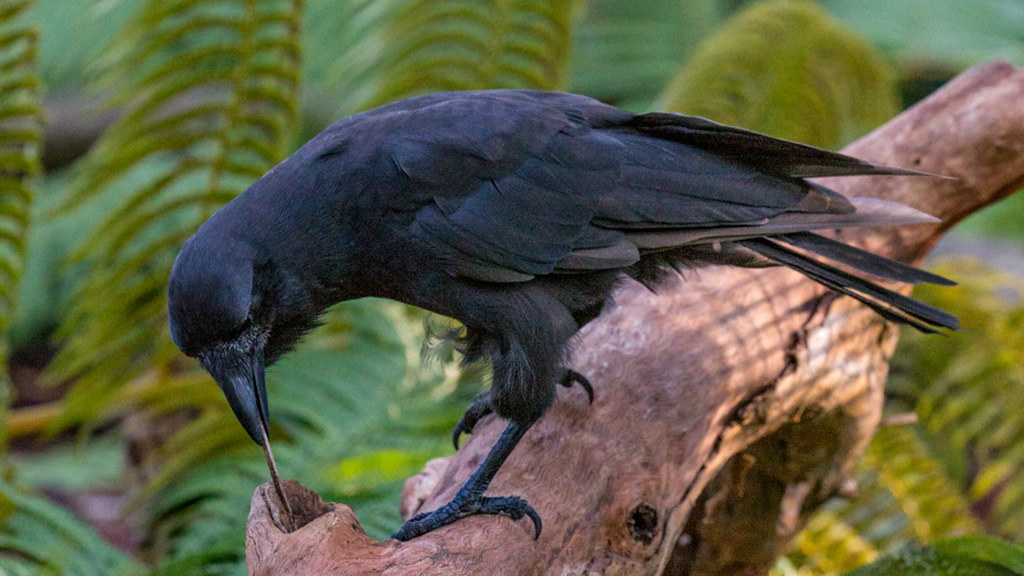An international team of scientists, including Dr Richard James from the Department of Physics, and conservation experts has discovered that the critically-endangered Hawaiian crow, or ‘Alalā, is a highly proficient tool user, according to a paper published today in the leading scientific journal Nature.
"Remarkable tool-using skills"
For decades, another species – the famed New Caledonian crow – had baffled researchers with its remarkable tool-using skills. These birds, which only live on the remote South Pacific island of New Caledonia, use tools to winkle insects and other prey from deadwood and vegetation, exhibiting an astonishing degree of dexterity. The big question was why they, but apparently no other members of the crow family (‘corvids’), had evolved such technological prowess. But without other tool-using crow species for comparison, the New Caledonian crow remained a puzzling oddity.
There are over 40 species of crows and ravens in the world, and many of them – especially those living in remote tropical locations – remain poorly studied. “This raises the intriguing possibility that there are some undiscovered tool users out there,” explains the study’s lead scientist, Dr Christian Rutz, from the University of St Andrews, UK.
“We had previously noticed that New Caledonian crows have unusually straight bills, and wondered whether this may be an adaptation for holding tools, similar to humans’ opposable thumb,” Rutz elaborates. By searching for this tell-tale sign amongst some of the lesser-known corvid species, he quickly homed in on a particularly promising candidate for further investigation – the ‘Alalā.
Following a population crash in the late 20th century, the ‘Alalā is now sadly extinct in the wild. In a last-ditch effort to preserve the species, the remaining wild birds were brought into captivity, to launch a breeding programme. “Later this year, in collaboration with our partners, we will be releasing captive-reared ‘Alalā on Hawai‘i Island, to re-establish a wild population,” says Bryce Masuda, co-leader of the study and Conservation Program Manager of San Diego Zoo Global’s Hawai‘i Endangered Bird Conservation Program.
Masuda was excited when the St Andrews scientists got in touch with his team: “We had occasionally seen birds using stick tools at our two breeding facilities, but hadn’t thought much of it.” The St Andrews and San Diego teams quickly agreed to conduct a collaborative project, to examine the tool-using skills of ‘Alalā under controlled conditions.
Using tools comes naturally
“We tested 104 of the 109 ‘Alalā alive at the time, and found that the vast majority of them spontaneously used tools,” says Masuda. Current evidence strongly suggests that tool use is part of the species’ natural behavioural repertoire, rather than being a quirk that arose in captivity, according to Rutz: “Using tools comes naturally to ‘Alalā. These birds had no specific training prior to our study, yet most of them were incredibly skilled at handling stick tools, and even swiftly extracted bait from demanding tasks. In many regards, the ‘Alalā is very similar to the New Caledonian crow, which my team has been studying for over 10 years.”
Dr Richard James, Director of the Centre for Networks and Collective Behaviour in the University’s Department of Physics, carried out extensive computer simulations to demonstrate that it is unlikely that a single bird once had a smart idea, which subsequently spread across the captive population through social learning.
He said: “This was a rare opportunity to be involved in a discovery-led project, and one that will enrich both academic studies of tool-use in animals and the programme to re-introduce this particular species to the wild. A key interest is to unpick whether tool-use is inherited, or learned from parents or from non-kin.”
The discovery of a second tool-using crow species finally provides leverage for addressing long-standing questions about the evolution of animal tool behaviour. “As crow species go, the ‘Alalā and the New Caledonian crow are only very distantly related. With their last common ancestor living around 11 million years ago, it seems safe to assume that their tool-using skills arose independently,” explains Rutz. “It is striking that both species evolved on remote tropical islands in the Pacific Ocean that lack woodpeckers and ferocious bird predators – perfect conditions, apparently, for smart crows to become accomplished tool users!”

